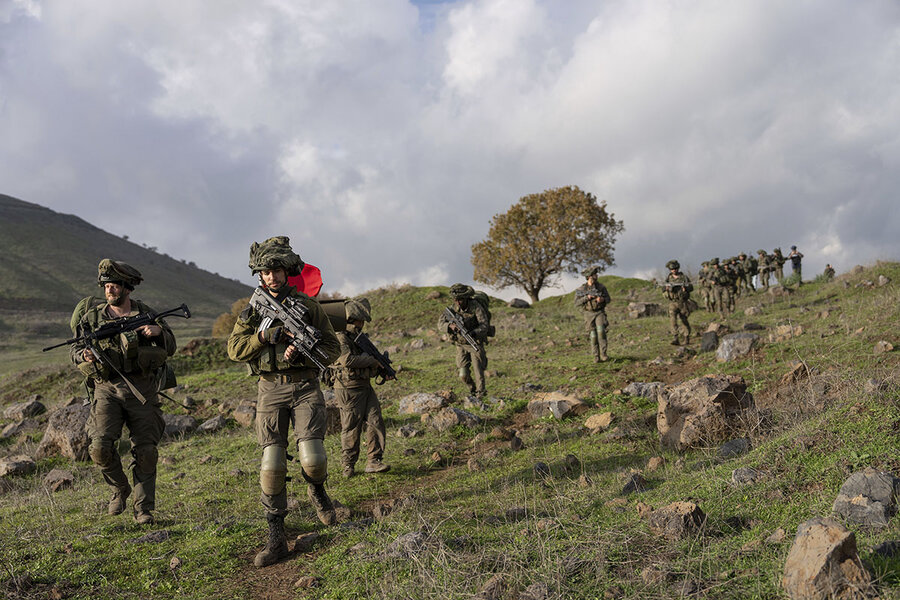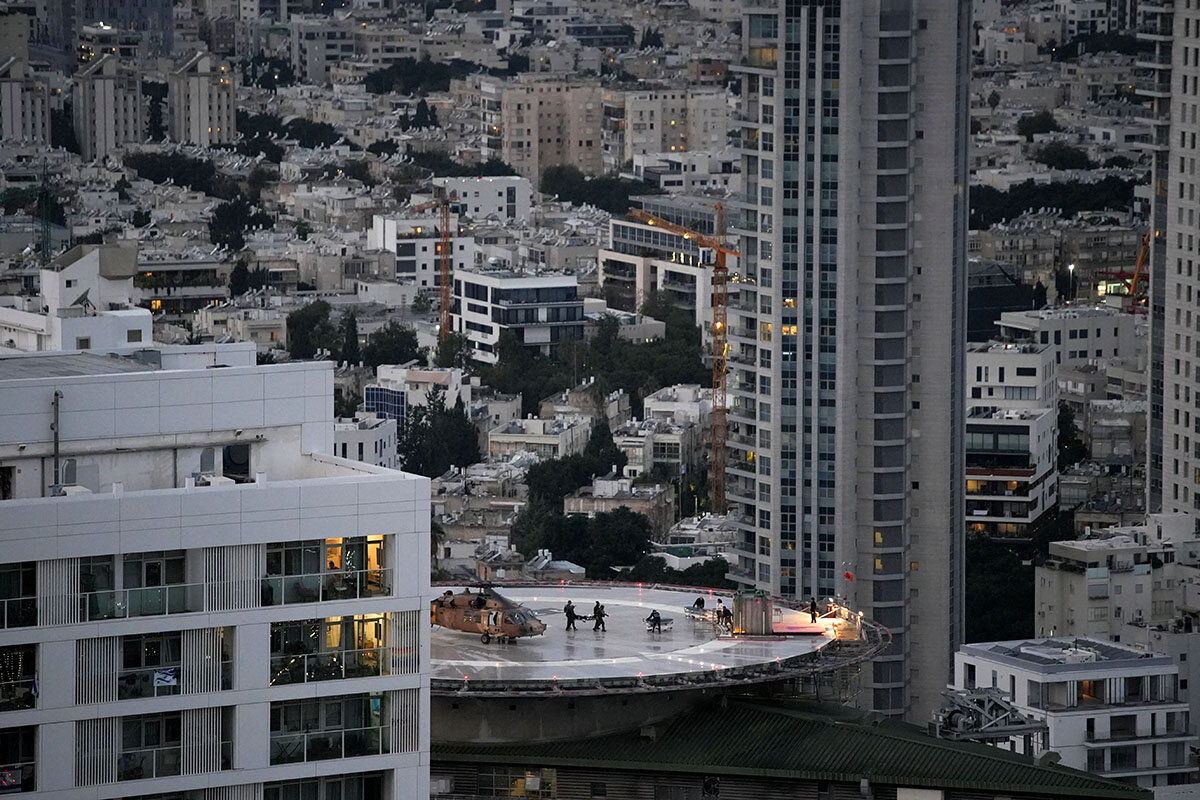Lives on hold, economy in check: Gaza war tests Israel’s stamina
Loading...
| TEL AVIV, Israel
Ori Barzilay was planning his wedding when Hamas launched its devastating Oct. 7 attack on Israel.
Like more than 300,000 other Israeli civilians, he immediately left his regular life and went off to war, in his case as a reservist in an elite intelligence unit.
After nearly three straight months in uniform, he only recently returned home, part of a wider demobilization – for now – of Israeli forces.
Why We Wrote This
A story focused onWar brings clear costs: lives lost or forever changed, homes destroyed. As Israel girds for a long war in Gaza, and tensions rise in Lebanon, it is trying to balance, too, the human and economic costs of mass mobilization.
As the campaign against Hamas grinds on in Gaza, and the threat of a wider escalation with the Iran-backed Hezbollah grows in Lebanon, Israel is digging in for a long war – militarily, economically, and socially. It’s an effort both to achieve its ambitious objectives and to make the battle sustainable for its citizenry.
“The year 2024 will be challenging,” Israel’s military chief, Lt. Gen. Herzi Halevi, said Sunday. “We will be fighting in Gaza all year, that’s for sure, and this will also hold [for] the other arenas.”
Mr. Barzilay, a principal at Team8, a Tel Aviv-based tech investment firm, was told by his commanders not to get too comfortable back in civilian life.
“We were kind of released,” he says, adding that it was made clear to him to be ready to meet the army’s needs for the entirety of the coming year.
“There will be peaks up and down. It’s not [a binary] 0 or 1; it’s a dynamic situation,” he adds.
“Lower-intensity” phase
Now over three months into the war in Gaza, much of Israel has returned to a semblance of (wartime) normalcy.
Rocket barrages from the battered Palestinian enclave onto Israeli cities have nearly stopped, with more incoming alerts tallied in northern Israel in recent weeks due to intensifying Hezbollah fire. At the stroke of midnight on New Year’s Eve, revelers in Tel Aviv barely heard the last major Hamas volley – and those that did continued with the festivities until the small hours of the night.
On the ground inside the Gaza Strip, the Israeli military has shifted to a “lower-intensity” phase of its offensive, at least in the northern part of the territory, deploying less firepower and more targeted raids against Hamas targets. While heavy fighting has continued in Gaza’s center and south, the need for the same level of massed Israeli army divisions – and reservists – has decreased.
Yet Israeli military officers maintain that much work remains to be done: Half of Hamas’ 24 battalions are still functioning, the group’s leadership is still alive, and there are still more than 100 Israelis being held hostage inside Gaza.
In tandem, tensions are also growing with Hezbollah, with the powerful Shiite movement exchanging fire daily with Israeli forces.
Last week, a senior Hamas leader, Saleh al-Arouri, was killed in a suspected Israeli missile strike in Beirut. Hezbollah vowed to retaliate, and this past weekend fired on a critical Israeli military installation as part of what it termed an “initial response.” On Monday Hezbollah said a senior commander, Wissam Hassan Tawil, had been killed in an Israeli airstrike.
More than 80,000 Israelis have been displaced from their homes on Israel’s northern border, heaping pressure on the government of Prime Minister Benjamin Netanyahu to find a solution to the Hezbollah threat – whether via ongoing United States-backed diplomatic efforts or through military force.
“The probability of [outright] conflict in the north is greater than 50%,” said Gabi Ashkenazi, a former Israeli military chief and foreign minister, at a recent economics conference at Herzliya’s Reichman University. “So we have to assume that we’ll need to deploy force.”
Facing such an array of uncertainties over an extended period of time, Israel now intends to make the situation more workable, especially on the home front.
“The reserve array will be built in such a way that they can go out to freshen up, the Israeli economy can function, [and] families waiting for their loved ones can get back to routine,” Rear Adm. Daniel Hagari, the chief military spokesperson, said last week. “The fighting will be long, there are many challenges, and we must do this. ... We will still need the reservist forces” in the future.
Yearning for normality
At the economics conference where Lieutenant General Ashkenazi spoke, university students milled about, their semester only just beginning in late December. Those young reservists who had already been released were recognizable for the assault rifles slung over their shoulders, alongside their backpacks.
Inside the lecture hall, finance officials and academics attending the conference put on by the Aaron Institute for Economic Policy were of one mind: The Israeli economy in the coming year was looking at slower growth (and likely a recession), with higher budget deficits due to the massive cost of the war, including increased defense spending to levels not seen in decades.
“Oct. 7 was a transformative date for Israel. ... Our defense doctrine collapsed,” said Maj. Gen. Amos Yadlin, a former military intelligence chief, on a recent call with journalists.
“[Now] what is needed is a different defense doctrine, with different initiatives. The [prior] addiction to tranquility is gone,” he said in remarks directed at Hamas, Hezbollah, and other external Israeli enemies. “Those who don’t understand that will feel the fire.”
Yet tranquility and normality and routine are exactly what Israelis, and especially those on the home front, yearn for – even in wartime. The toll on reservists, and their families, has been immense.
Ben, a reserve officer in a combat brigade headquarters who asked that his full name not be used, was mobilized and deployed last month to the Gaza front. Unlike others in his unit, he tries to make it back home every night, even if just for a few hours, to see his 1-year-old son and wife.
“It’s been very difficult on her; she’s exhausted,” Ben says. “There are a lot of babysitters and family help ... and we have it easier than most.” His wife was recently told she’s being laid off, an economic blow that other reservists, especially those who are self-employed, are well acquainted with.
Yet despite it all, Ben adds, “no one is eager to end this before we finish the job” against Hamas. “Time is working in our favor. Every day we’re there [inside Gaza], we’re dismantling them.”
The certainty of uncertainty
This shared sense of mission, even months into one of Israel’s longest wars, is still evident – despite the high cost and, oftentimes, dissonance of the current moment.
After returning home, the 29-year-old Mr. Barzilay found the “routine” of go-go Tel Aviv, with its bars and cafes full again, “very odd and strange” after the reality of military life and the scenes of devastation in Gaza.
“But later I realized it’s a wonderful thing to see, and also important for the economy, which is no less an important front in this war. This is why I do reserve duty, to protect it all,” he says.
As for his upcoming wedding, those plans are still on hold: The uncertainty of the current moment is the only certainty.
His fiancée, a medical student, was also called up for reserve duty. Unlike him, she has yet to be demobilized.
“We were looking at this coming spring, and we still want to do it then. But it’s an open question whether it’ll be possible,” he says. “It’s the first time our generation has experienced a war of this magnitude.”







